Benq Joybook Q41 User Manual

Joybook Q41 Series User Manual
Welcome
Copyright
Copyright 2007 by BenQ Corporation. All rights reserved. No part of this publication may be reproduced, transmitted, transcribed, stored in a retrieval system or translated into any language or computer language, in any form or by any means, electronic, mechanical, magnetic, optical, chemical, manual or otherwise, without the prior written permission of this company.
Disclaimer
BenQ Corporation makes no representations or warranties, either expressed or implied, with respect to the contents hereof and specifically disclaims any warranties, merchantability or fitness for any particular purpose. Further, BenQ Corporation reserves the right to revise this publication and to make changes from time to time in the contents hereof without obligation of this company to notify any person of such revision or changes.
Windows, Internet Explorer, and Windows Mail are trademarks of Microsoft Corporation. Others are copyrights of their respective companies or organizations.
The Bluetooth word mark and logo are registered trademarks and are owned by the Bluetooth SIG, Inc. All other trademarks are registered by their respective owners.
Joybook models covered by this manual
This manual contains the information about the following Joybook models:
• Joybook Q41 Series
Please note that the actual hardware or software capabilities will vary according to the model you purchased. To determine your Joybook model, please refer to the label on the packing box, or the printing on your Joybook.
Table of Contents |
|
Overview ......................................................................................... |
1 |
About this book........................................................................... |
1 |
Typographics............................................................................... |
2 |
Getting started................................................................................ |
3 |
Package contents ......................................................................... |
3 |
Getting your Joybook ready for use ........................................... |
3 |
Expanding the capabilities of your Joybook.............................. |
6 |
Touring your Joybook.................................................................... |
9 |
Front view ................................................................................ |
9 |
Left side view ............................................................................. |
10 |
Right side view .......................................................................... |
12 |
Top view/rear view.................................................................... |
14 |
Bottom view .............................................................................. |
15 |
Indicators................................................................................... |
16 |
Getting started with Windows Vista........................................... |
17 |
Turning off your Joybook properly ......................................... |
17 |
Using Windows Mobility Center ............................................. |
18 |
Using your Joybook...................................................................... |
19 |
Using the touchpad................................................................... |
19 |
Using the keyboard ................................................................... |
21 |
Function hotkeys ................................................................ |
21 |
Windows key shortcuts and other keys ............................. |
23 |
Using built-in wireless connectivity (available on selected |
|
models) ...................................................................................... |
25 |
Connecting to a wireless network:..................................... |
25 |
Using Bluetooth (available on selected models) ..................... |
27 |
Connecting to a Bluetooth device ..................................... |
27 |
Sending a file to a Bluetooth device .................................. |
31 |
Using QMedia Bar.................................................................... |
33 |
Introduction to QMedia Bar ............................................. |
33 |
Setting up QMedia Bar ...................................................... |
33 |
Using Windows® SideShow™ ..................................................... |
34 |
Introduction to the built-in SideShow device......................... |
35 |
Starting up .......................................................................... |
35 |
Launching a gadget ............................................................ |
35 |
Using the contextual menu................................................ |
36 |
Locking or unlocking buttons ..................................... |
36 |
Deleting data ................................................................ |
36 |
Getting started with gadgets..................................................... |
36 |
Checking PC Status ............................................................ |
37 |
Using Music Player............................................................. |
37 |
Playing music files........................................................ |
37 |
Changing Music Player settings .................................. |
38 |
Operating the Nowplaying View screen ..................... |
38 |
Using SlideShow Player...................................................... |
39 |
Displaying image files .................................................. |
39 |
Changing SlideShow Player settings ........................... |
39 |
Synchronizing to the SideShow device.............................. |
40 |
Using Solitaire .................................................................... |
41 |
Using Windows Media Player ........................................... |
42 |
Playing music files........................................................ |
42 |
Adding music files to the Now Playing list................. |
43 |
Table of Contents |
iii |
Using Office PowerPoint Remote ...................................... |
44 |
Using Office Outlook 2007 Calendar................................. |
45 |
Using Office Outlook 2007 Contacts ................................. |
45 |
Using Office Outlook 2007 Mail ........................................ |
46 |
Using Windows Mail .......................................................... |
48 |
Using VoIP Phone............................................................... |
49 |
Dialing a contact ........................................................... |
49 |
Using the Dialer function............................................. |
50 |
Using Feed Viewer .............................................................. |
51 |
Finding and subscribing to RSS feeds.......................... |
51 |
Viewing RSS feeds with Feed Viewer........................... |
51 |
Customizing SideShow settings................................................ |
54 |
Using BIOS setup ......................................................................... |
55 |
When and how to use BIOS setup............................................ |
55 |
Navigating the BIOS setup screen ............................................ |
56 |
Main menu .......................................................................... |
56 |
Security menu ..................................................................... |
57 |
Boot menu........................................................................... |
57 |
Exit menu ............................................................................ |
58 |
Boot from LAN.......................................................................... |
58 |
Recovering your system ............................................................... |
59 |
Using QDataTrove .................................................................... |
59 |
Launching QDataTrove...................................................... |
59 |
Backing up your system................................................ |
59 |
Restoring your Joybook to factory default settings..... |
60 |
Restoring your system with your backup image ......... |
60 |
Recovering your system using the supplied discs.................... |
61 |
Step 1: Reinstalling a clean copy of Windows Vista.......... |
61 |
Step 2: Reinstalling drivers and applications..................... |
62 |
Protecting your Joybook from viruses and other security |
|
threats ........................................................................................ |
62 |
Installing additional memory...................................................... |
63 |
FAQ and troubleshooting............................................................ |
66 |
General ...................................................................................... |
66 |
Battery and power..................................................................... |
66 |
Connection................................................................................ |
68 |
System........................................................................................ |
69 |
Display....................................................................................... |
73 |
Cleaning and battery maintenance ............................................. |
75 |
Battery maintenance................................................................. |
75 |
Cleaning your Joybook............................................................. |
75 |
Service and support...................................................................... |
76 |
BenQ Joybook Global Online Service...................................... |
76 |
Joybook Overseas Regional Warranty (ORW) online |
|
registration ................................................................................ |
76 |
Appendix....................................................................................... |
77 |
General safety information....................................................... |
77 |
Safety information about the battery....................................... |
77 |
Safety information about the power adapter .......................... |
78 |
Safety information about the modem ..................................... |
78 |
Caution ............................................................................... |
78 |
Disposal of Waste Electrical and Electronic Equipment by |
|
users in private households in the European Union. ............. |
78 |
Declaration of Conformity....................................................... |
79 |
Safety instructions for Poland, Romania, Slovenia, Bulgaria, |
|
Latvia, and Croatia.................................................................... |
80 |
iv Table of Contents
Overview
About this book
This book provides you the main information about various components in your Joybook and demonstrates how to use them. The following are the major chapters of this book.
Chapter title |
Description |
|
|
Overview |
Introduction to this book. |
|
|
Getting started |
Information about beginning to |
|
use your Joybook. |
|
|
Touring your Joybook |
Introduction to the hardware |
|
components of your Joybook. |
|
|
Getting started with |
Basic information about |
Windows Vista |
Windows Vista. |
|
|
Using your Joybook |
Basic and advanced |
|
information about operating |
|
your Joybook. |
|
|
Using Windows® |
Information about using the |
SideShow™ |
built-in SideShow device. |
|
|
Using BIOS setup |
Information about how to use |
|
the BIOS setup utility. |
|
|
Recovering your |
Information about using system |
system |
recovery tools. |
|
|
Installing additional |
Information about how to add |
memory |
additional RAM memory. |
|
|
FAQ and |
Information about frequently |
troubleshooting |
asked questions and |
|
troubleshooting. |
|
|
Cleaning and battery |
Information about cleaning and |
maintenance |
battery maintenance. |
|
|
Service and support |
Joybook service and support |
|
information. |
|
|
Appendix |
Important safety information. |
|
|
Overview 1

Typographics
The usage of notes, tips, and warnings in this manual is specifically for different purposes, which are described as follows:
Icon/ |
Item |
Meaning |
Symbol |
|
|
|
|
|
|
Warning |
Information mainly to |
|
|
prevent the damage to |
|
|
components, data, or |
|
|
personal injury caused by |
|
|
misuse and improper |
|
|
operation or behavior. |
|
|
|
|
Tip |
Useful information for |
|
|
completing a task. |
|
|
|
|
Note |
Supplementary information. |
|
|
|
< > or [ ] |
Keys on the |
Indicates a key on the |
|
keyboard; User |
keyboard, or the UI on the |
|
Interface (UI) |
screen. Do not actually type |
|
on the screen |
the symbols together with |
|
|
the enclosed letters. |
|
|
|
2 Overview

Getting started
 Depending on the model of your Joybook, the appearance may be different from the illustrations shown in this manual.
Depending on the model of your Joybook, the appearance may be different from the illustrations shown in this manual.
Package contents
Before using your Joybook for the first time, please check if you have all the items with you. For details about what should be included in the package, refer to the Package Contents label inside the accessory box. If any of the items are missing or appear damaged, contact your dealer immediately. Save the packaging in case you need to ship your Joybook for service.
Getting your Joybook ready for use
1. Installing the battery pack
Battery retainer B
Close the lid of your Joybook (if open). Turn your Joybook upside down and place it on a soft clean cloth. With the label side of the battery pack facing down, slide it gently into the battery compartment until it snaps into place (1). Move "Battery retainer B" to the left as shown to lock the battery pack into place (2).
Getting started |
3 |
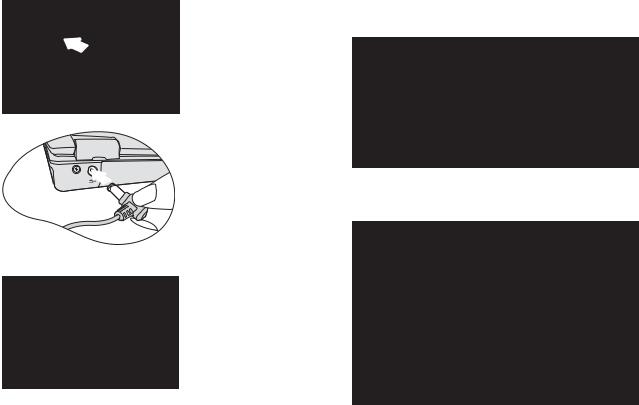
2. Connecting the power
Connect the power cord to the power adapter.
Connect the power adapter to the power socket on your Joybook.
Connect the power cord to a wall outlet. The Joybook will automatically start charging the battery.
 • The battery pack is shipped with low charge from the factory. You can still use your Joybook while the battery is charging.
• The battery pack is shipped with low charge from the factory. You can still use your Joybook while the battery is charging.
•Power systems and plug types may vary depending on your country/region.
•When the battery is charging, the battery indicator appears in amber. When the battery is fully charged, the light goes off.
•For details about the colors and meanings of the indicators, refer to "Indicators" on page 16.
3. Opening your Joybook
Gently lift up the latchless lid that allows you to open the case easily.
4 Getting started

4. Performing initial setup
Press the Power button to start up your Joybook, and then follow the on-screen instructions to complete the initial Windows Vista setup.
 • Your Joybook Q41 Series works best with Windows Vista® Home Premium, Windows Vista® Business, or Windows Vista® Ultimate. Installing other operating systems that have not been tested is not recommended, and may not only void your warranty but also affect the functionality of your Joybook.
• Your Joybook Q41 Series works best with Windows Vista® Home Premium, Windows Vista® Business, or Windows Vista® Ultimate. Installing other operating systems that have not been tested is not recommended, and may not only void your warranty but also affect the functionality of your Joybook.
•The actual operating system that comes with your Joybook may vary. For details, refer to the Product Specification label on the product carton.
Getting started |
5 |

Expanding the capabilities of your Joybook
Connect an external display device (such as a monitor or projector) to the 15-pin D-sub video socket of your Joybook with a VGA cable.
 To switch to the external display device or simultaneous display, press the <Fn> + <F3> hotkey combination.
To switch to the external display device or simultaneous display, press the <Fn> + <F3> hotkey combination.
Connect USB peripherals to the USB port of your Joybook.
Insert an ExpressCard/34 module or ExpressCard/54 module to further expand the capabilities of your Joybook.
6 Getting started

Insert a Memory Stick, Memory Stick Pro, SD, or MMC memory card following the direction indicated on the card to exchange files.
Connect an earphone to the audio output socket to output sounds.
Connect a microphone to the microphone input socket to record sounds.
Use the optical drive to access data on various kinds of discs and enjoy movies or music.
Getting started |
7 |

Connect a telephone line to the modem port of your Joybook and dial-up to the Internet or send a fax.
Access local area network (LAN) by connecting a network cable to the LAN port of your Joybook.
8 Getting started

Touring your Joybook
Front view
(3) |
Keyboard |
(4) |
Touchpad |
(1) |
Refer to "Using the touchpad" on page 19 for |
|
details. |
|
(5) |
Built-in microphone |
|
|
Receives sounds and voices for recording. |
(2) |
(6) |
Speaker |
|
(7) |
Audio output socket |
(3) |
|
Can be used to connect to an earphone/headset |
(4) |
|
or external speaker for playing the Joybook audio. |
(5) |
|
|
|
|
(8) |
Microphone input socket |
|
|
|
Can be used to connect to a microphone for |
|
|
|
recording sounds. |
(6) |
(7)(8) |
(9) |
This socket is for 3.5mm analog audio plugs. It |
|
|
|
accepts both mono and stereo plugs. |
No. Front components
(1)LCD (Liquid Crystal Display) panel
(2) Power button
Power button
Turns your Joybook on or off.
(9)Indicators
Refer to "Indicators" on page 16 for details.
Touring your Joybook |
9 |

Left side view
(1) |
(2) |
(3) |
(4) |
(5) |
No. Left-side components
(1) 15-pin D-sub video socket
15-pin D-sub video socket
For connecting external display devices, such as monitors and projectors.
(2)Ventilation holes
For dissipating heat and keeping your Joybook at
an optimal temperature.
To prevent overheating, do not obstruct the vent. For example, do not use the Joybook in bed where a blanket may inadvertently cover the vent and block the airflow.
10 Touring your Joybook
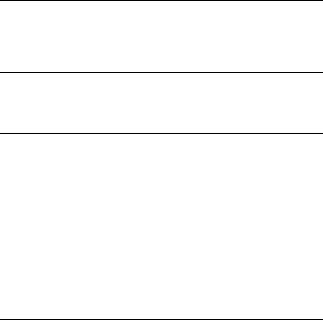
(3) USB ports
USB ports
For connecting peripherals such as mice, digital cameras and MP3 players that use the USB 2.0 interface.
(4) Four-in-One memory card slot
Four-in-One memory card slot
For a Memory Stick, Memory Stick Pro, SD, or MMC memory card.
(5)ExpressCard slot
This ExpressCard slot accepts two formats of the standard ExpressCard modules: ExpressCard/34 and ExpressCard/54. The ExpressCard/34 module is characterized by its 34 mm width, and the ExpressCard/54 module is characterized by its 54 mm width. You can use an ExpressCard to further expand the capabilities of your Joybook.
Insert an ExpressCard into the slot following the direction indicated on the card and complete related driver settings.
Touring your Joybook |
11 |

Right side view
(1)
No. Right-side components
(1)Speaker
(2) |
(3) |
(4) |
(5) |
(2)DVD/CD-RW Combo/DVD Super-Multi drive
(available on selected models)
The type of the optical drive varies by model, and the support of disc types depends on the optical drive that comes with your Joybook.
Supports multi-functional optical module for reading music CDs, VCDs and DVDs or burning CD-R/CD-RW or DVD+R/DVD-R/DVD+RW/DVD- RW/DVD-RAM (optional) discs. Discs can be inserted/ejected by pressing the small ejection button on the drive.
12 Touring your Joybook

(3)Optical drive ejection button
Discs can be inserted/ejected by pressing this ejection button.
(4)Manual tray opening
If you wish to open the disc tray when your Joybook power is off, or it can't be opened using the ejection button, insert a pointed object (like an opened paper clip) into the tray ejection hole next to the ejection button to release the disc tray.
(5) Modem port (RJ-11 connector)
Modem port (RJ-11 connector)
Accepts an analog telephone line for use with the internal modem.
•To reduce the risk of fire, ensure that your phone cable is of adequate capacity and approved for use with your local telecommunications supplier.
•This is the only telecommunications modem port on the Joybook. Please be careful to avoid plugging a narrow RJ-11 phone cable into the similar looking but wider RJ-45 LAN port on the rear side of the Joybook.
Touring your Joybook |
13 |
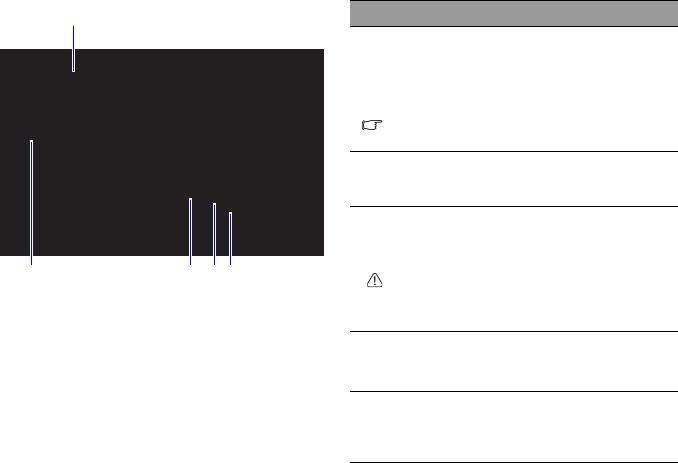
Top view/rear view
(1)
(2) |
(3) |
(4) (5) |
No. Top/rear components
(1)Built-in SideShow device
Your Joybook Q41 Series offers Windows® SideShow™ functionality, which enables you to enjoy gadgets and media on the go via an auxiliary display embedded in the lid. For details, refer to
"Using Windows® SideShow™" on page 34.
Microsoft Office 2007 (available on selected models) is required for full functionality of the SideShow device.
(2) Power socket
Power socket
For connecting AC power supply to power the Joybook and charge the battery.
(3)  LAN (Local Area Network) port (RJ-45 connector)
LAN (Local Area Network) port (RJ-45 connector)
Allows the Joybook to connect to a 10/100Mbps fast Ethernet 100BASE-T network.
Please be careful to avoid plugging a RJ-11 phone cable connector in the RJ-45 port. This will damage the LAN port. They look similar, but the RJ-45 connector is wider than the RJ-11 connector, and has more conductors.
(4) Anti-theft Kensington lock slot
Anti-theft Kensington lock slot
You can attach an anti-theft Kensington lock and cable to this slot to help prevent possible theft.
(5) USB port
USB port
For connecting peripherals such as mice, digital cameras and MP3 players that use the USB 2.0 interface.
14 Touring your Joybook
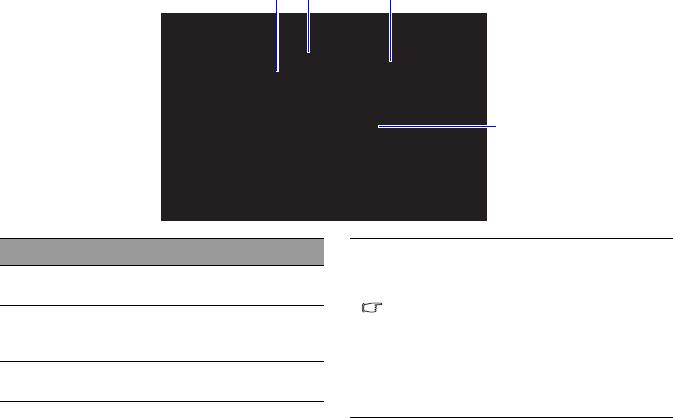
Bottom view
(1) (2)
No. Bottom components
(1)Battery retainer A
Secures the battery in place.
(2)Battery pack
Supplies power to the Joybook when external power is not connected.
(3)Battery retainer B
Secures the battery in place.
(3)
(4)
(4)MiniCard and memory expansion slot cover
Inside the cover, you can find the memory slot of the Joybook. There is also a MiniCard slot for
using an optional MiniCard.
• A wireless network card in the MiniCard form-factor design may have been built in on selected models.
•To remove the cover, a small Phillips head screwdriver is required.
•For more information about adding additional memory, the limit of maximum memory, or the types of BenQ certified memory modules for your Joybook, refer to "Installing additional memory" on page 63.
Touring your Joybook |
15 |
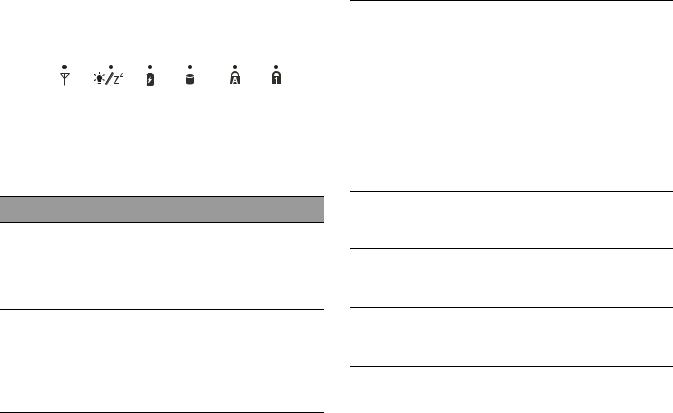
Indicators
|
|
|
|
|
|
|
|
|
|
|
|
|
|
|
|
|
|
|
|
|
|
|
|
|
|
|
|
|
|
|
|
|
|
|
|
(1) |
(2) |
(3) |
(4) |
(5) |
(6) |
||||||
No. Indicators
(1) Wireless network/Bluetooth indicator
Wireless network/Bluetooth indicator
•When the wireless LAN is on, it lights up in blue.
•When the Bluetooth is on, it lights up in amber.
•When the wireless LAN and Bluetooth are both on, it lights up in purple.
(2) System status indicator
System status indicator
•When the system is on, it lights up in blue.
•When the system is in Sleep mode, it fades in and out gradually in blue.
•When the system is off or in Hibernation, the blue light goes off.
(3) Battery indicator
Battery indicator
•When the system is on and the battery is in use, it lights up in blue.
•When the battery is charging, it lights up in amber.
•When the battery is fully charged, the amber light goes off.
•Flashing blue indicates that the battery is running low.
•Flashing amber indicates that the battery is malfunctioning, in which case you should contact service personnel.
(4) Hard disk activity indicator
Hard disk activity indicator
Flashes in blue when the Joybook is accessing data in the hard disk.
(5) Caps Lock indicator
Caps Lock indicator
Lights up in blue when the <Caps Lock> key is enabled.
(6) Num Lock indicator
Num Lock indicator
Lights up in blue when the <Num Lk> key is enabled.
16 Touring your Joybook
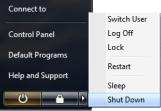
Getting started with Windows Vista
Depending on your purchased model, your Joybook may come pre-installed with the latest Microsoft operating system: Windows Vista® Home Premium, Windows Vista® Business, or Windows Vista® Ultimate.
When you first set up your Joybook, you may want to find information about the following topics. Refer to the user manual that is supplied with your operating system, or search from Help and Support in the Start menu.
•How to set the system region settings, date, and time.
•How to set system administrator and user security logins and settings.
•How to install, setup and run anti-virus software.
•How to name the computer for network identification.
•How to connect to a local network wirelessly or by cable.
•How to connect to another computer over a network and share files.
•How to connect with a network or shared printer.
•How to connect to the Internet.
•How to register Windows and other packaged software.
•How to update Windows with the latest service packs and security patches.
•How to synchronize the system clock with an Internet time server.
•How to locate, download, and install latest system device drivers.
• How to setup scheduled events for system maintenance.
Turning off your Joybook properly
By Windows default, the Start menu power button  puts your Joybook into Sleep mode. Therefore, if you wish to turn off the power of your Joybook completely, click the Start menu, click the arrow next to the Lock button, and then click Shut Down.
puts your Joybook into Sleep mode. Therefore, if you wish to turn off the power of your Joybook completely, click the Start menu, click the arrow next to the Lock button, and then click Shut Down.
Alternatively, you can customize the function of the Start menu power button by following the steps below:
1.Right-click the battery meter icon ( or
or  ) in the notification area located in the lower right corner of the desktop, and then click Power Options.
) in the notification area located in the lower right corner of the desktop, and then click Power Options.
2.On the Select a power plan screen, click Change plan settings under the selected plan.
3.Click Change advanced power settings.
Getting started with Windows Vista |
17 |
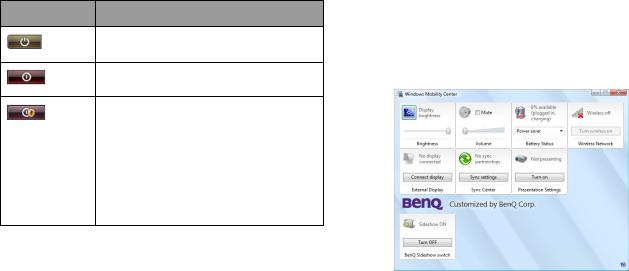
4.On the Advanced settings tab, double-click Power buttons and lid to expand this category.
5.Then, double-click Start menu power button to expand this item.
6.To specify the action to take when you press the Start menu power button, click On battery or Plugged in, and then select the desired setting from the drop-down list.
The Start menu power button may look different according to your settings
Appearances Functions
Puts your Joybook into Sleep mode.
Shuts down your Joybook.
Installs the Windows updates when available, and then shuts down your Joybook after the installation is complete.
This form of power button is only available when you’ve set your Joybook to receive updates automatically.
Using Windows Mobility
Center
Windows Mobility Center is a convenient location where you can quickly access your Joybook's settings, such as brightness, volume, battery status, and wireless network, etc.
To open Windows Mobility Center, press the <Fn> + <F10> hotkey combination, or do one of the following:
•Click Start, Control Panel, Mobile PC, and then click Windows Mobility Center.
•Click the battery meter icon ( or
or  ) in the notification area located in the lower right corner of the desktop, and then click Windows Mobility Center.
) in the notification area located in the lower right corner of the desktop, and then click Windows Mobility Center.
 • You can enable or disable the SideShow device for each Windows session from Windows Mobility Center.
• You can enable or disable the SideShow device for each Windows session from Windows Mobility Center.
• You can use the BIOS setup utility to make the SideShow device always OFF. For details, refer to "Main menu" on page 56.
18 Getting started with Windows Vista
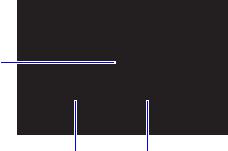
Using your Joybook
Using the touchpad
(1)
(2)(3)
The touchpad with its buttons is a pointing device that functions as an optional external mouse, which can perform navigation, scrolling and selection functions. The components of the touchpad are described as follows.
No. |
Component |
Function |
|
|
|
(1) |
Touchpad |
Moves the pointer, selects or |
|
|
activates items on the screen. |
|
|
|
(2) |
Left touchpad |
Equivalent to the left button of |
|
button |
an optional external mouse. |
|
|
|
(3) |
Right touchpad |
Equivalent to the right button |
|
button |
of an optional external mouse. |
|
|
|
•To use the touchpad as an optional external mouse, press the left and right touchpad buttons, which provide the same click functions as an external mouse does.
•To move the pointer, place your finger with slight pressure on the touchpad and move in the direction as desired.
 • Do not use a pen, pencil, or marker on the touchpad. Use only your fingertip.
• Do not use a pen, pencil, or marker on the touchpad. Use only your fingertip.
•To set the touchpad preferences in Windows Vista, select Start, Control Panel, Hardware and Sound, and Mouse.
Using your Joybook |
19 |
Function |
Left |
Right |
Touchpad |
|
touchpad |
touchpad |
|
|
button |
button |
|
|
|
|
|
Select |
Click once. |
|
Tap once. |
|
|
|
|
Execute |
Click twice |
|
Tap twice |
|
quickly. |
|
quickly. |
|
|
|
|
Drag |
Click once |
|
Tap twice |
|
and hold the |
|
quickly and |
|
item, and |
|
hold the |
|
then use |
|
item, and |
|
your finger |
|
then move |
|
on the |
|
your finger |
|
touchpad to |
|
on the |
|
drag. |
|
touchpad to |
|
|
|
drag. |
|
|
|
|
Display |
|
Click once. |
|
the |
|
|
|
context |
|
|
|
menu |
|
|
|
|
|
|
|
 The touchpad is a pressure sensitive device that requires proper care to avoid damage.
The touchpad is a pressure sensitive device that requires proper care to avoid damage.
•Do not rest heavy objects on the touchpad or its buttons.
•Do not scratch the touchpad with sharp-pointed objects or your fingernails.
20 Using your Joybook
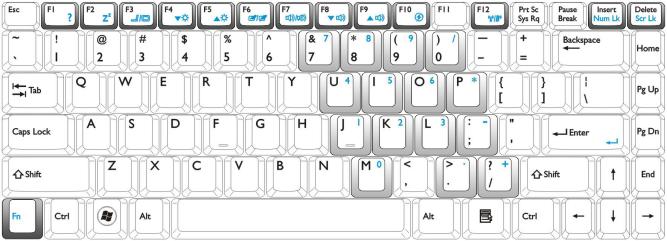
Using the keyboard
Function hotkeys
You can use the function hotkeys to access commonly used functions or make quick settings. To use the hotkeys, press and hold the <Fn> (Function) key at the lower left corner of the keyboard, and then press the desired hotkey.
 The appearance of the keyboard legend may vary depending on the country/region of your purchase.
The appearance of the keyboard legend may vary depending on the country/region of your purchase.
Using your Joybook |
21 |

Function hotkey |
Description |
Function hotkey |
Description |
|
|
|
|
<Fn> + <F1> |
Opens function hotkeys online help. |
<Fn> + <F8> |
Decreases volume. |
|
|
|
|
<Fn> + <F2> |
Puts your Joybook into Sleep mode. |
<Fn> + <F9> |
Increases volume. |
|
|
|
|
<Fn> + <F3> |
Switches display between your |
<Fn> + <F10> |
Opens or closes Windows Mobility |
|
Joybook and an external display device |
|
Center. |
|
(such as a monitor or projector), or |
|
For details about using Windows |
|
allows simultaneous display. |
|
Mobility Center, refer to "Using Windows |
|
Make sure an external display device |
|
Mobility Center" on page 18. |
|
(such as a monitor or projector) has been |
|
|
|
connected to your Joybook properly before |
|
|
|
using this hotkey combination. |
|
|
|
|
|
|
<Fn> + <F4> |
Decreases screen brightness. |
<Fn> + <F12> |
Turns WLAN and Bluetooth on or off. |
|
|
|
The status is indicated by the on- |
|
|
|
screen display. |
|
|
|
WLAN and Bluetooth are available on |
|
|
|
selected models. |
|
|
|
|
<Fn> + <F5> |
Increases screen brightness. |
<Fn> + <Num Lk> |
Activates or deactivates the numeric |
|
|
|
keypad integrated in the keyboard |
|
|
|
(indicated by the light gray shade in the |
|
|
|
illustration on the previous page). |
|
|
|
|
<Fn> + <F6> |
Activates or deactivates the touchpad. |
<Fn> + <Scr Lk> |
Activates or deactivates the scroll lock |
|
|
|
function. When activated, the screen |
<Fn> + <F7> |
Activates or deactivates the speakers. |
|
|
|
moves one line up or down when you |
||
|
|
|
press the up or down arrow key ( , ). |
|
|
|
Scroll Lock does not work in all |
|
|
|
programs. |
|
|
|
|
22 Using your Joybook
